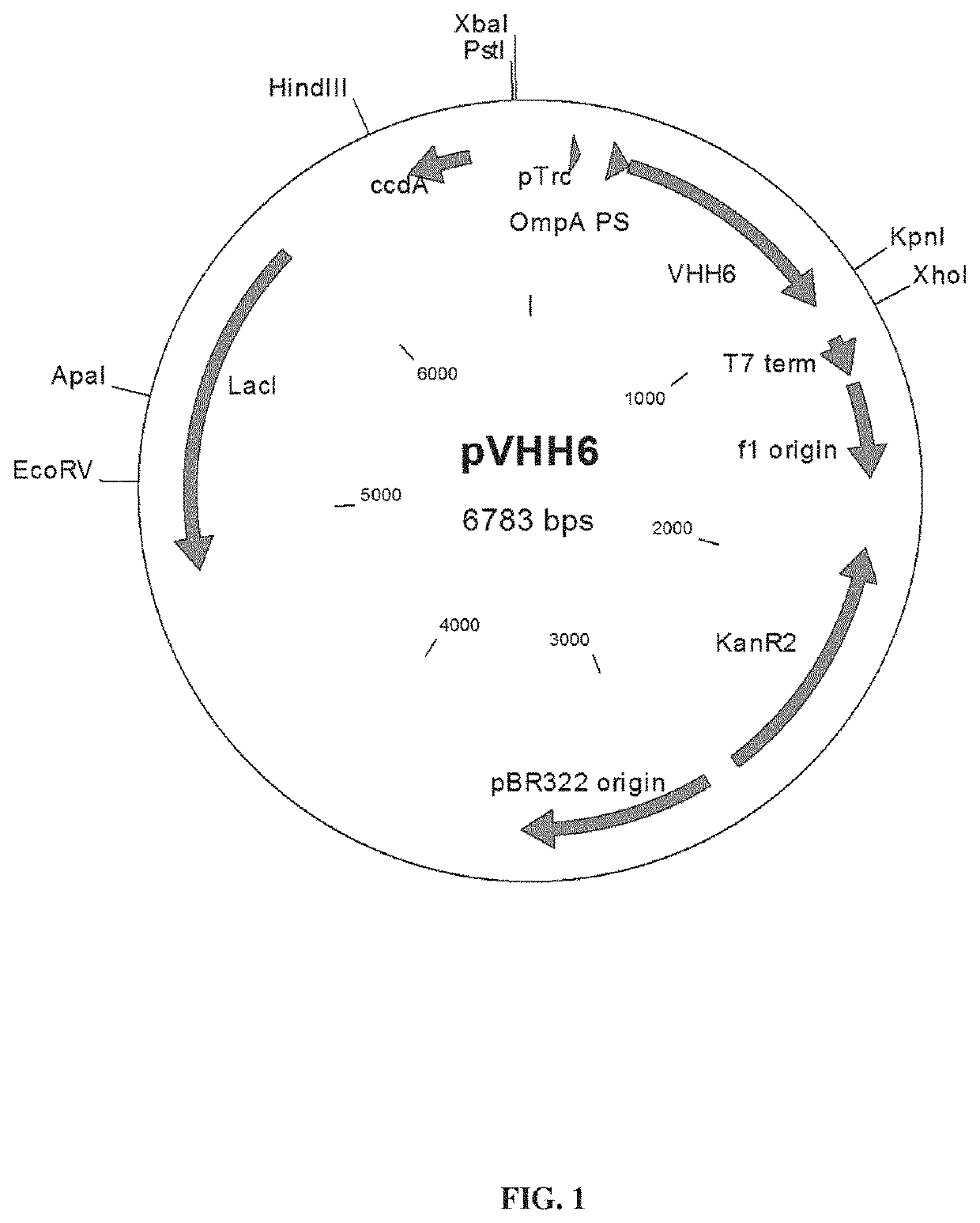Host cell for producing proteins
a technology of host cells and proteins, applied in the field of heterologous systems for recombinant protein production, can solve the problems of ccdb contamination of product or biomass by antibiotics (or genes encoding antibiotic resistance), limited plasmid maintenance within microorganisms, protein production, etc., to reduce or suppress the effect of corresponding toxic molecules, reduce or suppress the effect of ccdb, and easy deduction
- Summary
- Abstract
- Description
- Claims
- Application Information
AI Technical Summary
Benefits of technology
Problems solved by technology
Method used
Image
Examples
example 1
on of the ccdB Gene Increases YieldPproduction
[0190]In order to test the stability brought by the Staby® technology (technology based on the insertion of one copy of the ccdB gene within the host chromosome, Delphi Genetics, StabyExpress® products, patent WO9958652), we produced a secreted protein (a variable heavy chain antibody fragment named VHH6) which seems to have also toxic properties in E. coli. The W3110 E. coli strain (genetic background: E. coli K12, genotype: F− lambda− INV(rrnD-rrnE) rph-1) was used as producer host and expression was realized with pTrc promoter on a pBR322 vector (pVHH6; FIG. 1). The production of the W3110 strain using classical antibiotic stabilisation system (here the kanamycin resistance) was compared to the production of the W3110ccdB strain which has been modified to use the Staby® technology (ccdB gene being introduced inside the strain chromosome). Vectors used for this comparison both contained the ccdA gene and the vector used in W3110ccdB wa...
example 2
on of the Staby® 2ccdB Technology to Produce Other Proteins
[0198]In order to test if the use of the strains with two copies of the ccdB gene is possible for all proteins (including proteins already well expressed with only one copy of ccdB), we tested the production of the TraG protein of 70 kDa (Szpirer et al., 2000, Mol. Microbiol. 37(6) 1283-1292). W3110(DE3)ccdB and W3110(DE3)2ccdB strains with the plasmid coding for the antidote CcdA and TraG (pTraG) were constructed (FIG. 4). The traG gene was under the control of the T7 promoter. These strains and plasmid use the Staby® technology to stabilize the plasmids. The first observation was that in the presence of the plasmid encoding ccdA, the presence of two copies of the ccdB gene does not affect the viability nor the growth of the W3110 strain: one copy of the ccdA gene in the plasmid is enough to get full viability.
[0199]The production of TraG under the classical Staby® system (1 ccdB gene) is equivalent to the one with the new ...
example 3
on of the 2ccdB Technology to Produce Proteins in Other Host Strains
[0203]E. coli strains are divided in K12 and B types. As the W3110 strain is a K12 strain, the applicability of the 2ccdB technology to the B strains has been tested. Thus two copies of ccdB have been introduced in the genome of an E. coli B (BL21(DE3) type—Genetic background: E. coli B—genotype F—ompT gal dcm lon hsdSB(rB−mB−) λ(DE3 [lacI lacUV5-T7 gene1])) to give the SE3 strain. Then, perfused fermentation has been realized to produce the TraG protein after several generations. Stability of the plasmids after 24 h of induction is of 100% (FIG. 7). Every ccdB genes are intact under these conditions of expression.
[0204]Similar results were obtained in another K12 derived strain having the following genotype: F−endA1 glnV44 thi-1 recA1 relA1 gyrA96 deoR nupG Φ80dlacZΔM15Δ(lacZYA-argF)U169, hsdR17(rK−mK+), λ−, dcm::FRTccdB yjjK::FRTccdB. This strain was derived from DH5 alpha in which 2 copies of ccdB gene were inser...
PUM
| Property | Measurement | Unit |
|---|---|---|
| nucleic acid | aaaaa | aaaaa |
| antibiotic-resistance | aaaaa | aaaaa |
| antibiotic resistance | aaaaa | aaaaa |
Abstract
Description
Claims
Application Information
 Login to View More
Login to View More - R&D
- Intellectual Property
- Life Sciences
- Materials
- Tech Scout
- Unparalleled Data Quality
- Higher Quality Content
- 60% Fewer Hallucinations
Browse by: Latest US Patents, China's latest patents, Technical Efficacy Thesaurus, Application Domain, Technology Topic, Popular Technical Reports.
© 2025 PatSnap. All rights reserved.Legal|Privacy policy|Modern Slavery Act Transparency Statement|Sitemap|About US| Contact US: help@patsnap.com



